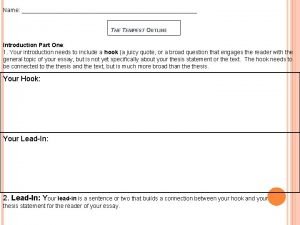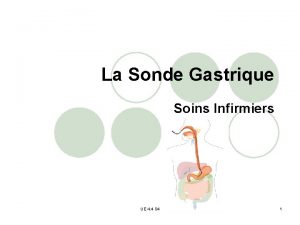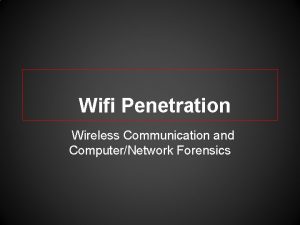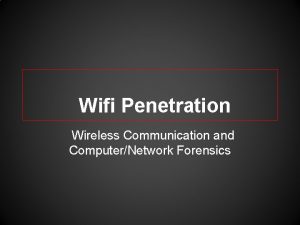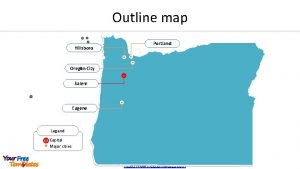ComputerNetwork Security Part 2 Yasamin salem 1 Outline























- Slides: 23

Computer/Network Security Part 2 Yasamin salem 1

Outline • Encryption Principles • Encryption Algorithms • Cipher Block Modes of Operation • Encryption Devices • Key Distribution 2

Cryptography Principles • Each cryptography method has five components: • • • Plaintext Encryption algorithm Secret Key Ciphertext Decryption algorithm 3

Cryptography Principles 4

Cryptography Issues • Cryptography algorithms are classified based on two independent issues: • The type of operations used for transforming plaintext to ciphertext • The number of keys used • symmetric (single key) • asymmetric (two-keys, or public/private key encryption) 5

Some of main crypto parameters • Block size: larger block sizes mean greater security • Key Size: larger key size means greater security • Number of rounds: multiple rounds offer increasing security • key generation algorithm: greater complexity will lead to greater difficulty of cryptanalysis. 6

Conventional Encryption Algorithms • Data Encryption Standard (DES) • • • The most widely used encryption scheme The algorithm is reffered to the Data Encryption Algorithm (DEA) DES is a block cipher The plaintext is processed in 64 -bit blocks The key is 56 -bits in length 7

Data Encryption Standard (DES) 8

DES (Single Round) • The overall processing at each iteration: • Li = Ri-1 • Ri = Li-1 F(Ri-1, Ki) 9

Triple DEA • Use three keys and three executions of the DES algorithm (encrypt-decrypt-encrypt) C = EK 3[DK 2[EK 1[P]]] • • C = ciphertext P = Plaintext EK[X] = encryption of X using key K DK[Y] = decryption of Y using key K • Effective key length of 168 bits 10

Other Symmetric Block Ciphers • International Data Encryption Algorithm (IDEA) • 128 -bit key • Used in PGP • Blowfish • Easy to implement • High execution speed • Run in less than 5 K of memory 11

Other Symmetric Block Ciphers • RC 5 • Suitable for hardware and software • Fast, simple • Adaptable to processors of different word lengths • Variable number of rounds • Variable-length key • Low memory requirement • High security • Cast-128 • Key size from 40 to 128 bits • The round function differs from round to round 12

Cipher Block Modes of Operation • Cipher Block Chaining Mode (CBC) • The input to the encryption algorithm is the XOR of the current plaintext block and the preceding ciphertext block. 13

Cipher Block Modes of Operation 14

15

Location of Encryption Devices • End-to-end encryption • The source encrypt and the receiver decrypts • Link encryption: • A lot of encryption devices • High level of security • Decrypt each packet at every switch • High Security: Both link and end-to-end encryption are needed 16

Encryption in Packet Switch Network 17

Key Distribution 1. A key could be selected by A and physically delivered to B. 18

Key Distribution • 2 - A third party could select the key and physically deliver it to A and B. 19

Key Distribution • 3 - If A and B have previously used a key, one party could transmit the new key to the other, encrypted using the old key. 20

Key Distribution • 4 -If A and B each have an encrypted connection to a third party C, C could deliver a key on the encrypted links to A and B. 21

Key Distribution • Session key: • Data encrypted with a one-time session key. At the conclusion of the session the key is destroyed • Permanent key: • Used between entities for the purpose of distributing session keys 22

Key Distribution for Connnection Oriented 23
 Yasamin shirazi
Yasamin shirazi Daimicilik ile esasicilik arasındaki farklar
Daimicilik ile esasicilik arasındaki farklar Gergedanlar ionesco
Gergedanlar ionesco Privat security
Privat security Example of quote sandwich
Example of quote sandwich Ap seminar part b outline
Ap seminar part b outline What is the name of the first part of an outline?
What is the name of the first part of an outline? Discovery education salem witch trials
Discovery education salem witch trials How quickly did things get out of hand in salem
How quickly did things get out of hand in salem Lydia darragh
Lydia darragh National geographic salem witch trials
National geographic salem witch trials Melquisedec rey de salem
Melquisedec rey de salem Wsfcs social studies
Wsfcs social studies Plateau
Plateau Nicole salem
Nicole salem Describe the types of homes that probably existed in salem
Describe the types of homes that probably existed in salem The crucible parris
The crucible parris Enteral tube feeding ati
Enteral tube feeding ati Dbq salem witch trials
Dbq salem witch trials What duty was mary warren performing in the court
What duty was mary warren performing in the court Nazogastrik sonda çeşitleri
Nazogastrik sonda çeşitleri Salem state msw
Salem state msw Tubage gastrique soins infirmiers
Tubage gastrique soins infirmiers Enema types
Enema types






